"An aircraft engineer can use this report to design adequate ice protection systems for any type aircraft for any flight mission profile." 1

Figure 4.2-2 of ADS-4.
Summary
The knowledge of aircraft icing matured to produce engineering design manuals.
Key Points
- NACA publications contributed heavily to later design manuals.
- Extensive design publications distilling research into practical methods appeared in the 1950s.
- I do not know of a comprehensive design resource for some recent topics such as 3D design and analysis.
Discussion
NACA had an early period (up to and including WWII) that was largely characterized by expeditious tests to address immediate icing problems. Later, NACA embarked on more scientifically oriented studies. The science and experience of aircraft ice protection had matured enough by the 1950s for comprehensive engineering design manuals to be written.
While NACA did not write all of the design manuals, all of the design manuals heavily relied on NACA references. Half of the references in ADS-4 "Engineering Summary of Airframe Icing Technical Data" are NACA references, and the main author, Dean Bowden, had published NACA icing papers.
The breadth of knowledge encapsulated in ADS-4 allowed the expansive claim in 1963:
"An aircraft engineer can use this report to design adequate ice protection systems for any type aircraft for any flight mission profile."
Other design manuals led up to ADS-4.
"Modern Icing Technology" 2
While not labeled a design guide, this publication had most of the parts one might expect in a design guide. Think of this as an excellent first draft for later design manuals.
FOREWORD
These notes are the outgrowth of a seminar on icing information given at the University of Michigan in the Fall of 1951. They are intended to be useful to the persons interested in entering the icing field who require a single source where either basic information or suitable references may be found.This first edition was rather hurriedly put together for use in a seconds seminar in February, 1952. Corrections and suggested additions will be most welcome.
For being "rather hurriedly put together", this is an extensive resource (153 pages).
TABLE OF CONTENTS
I AN INTRODUCTION TO THE ICING PROBLEM
II TRAJECTORIES OF WATER DROPS AROUND STREAMLINED BODIES
III REMOVING THE ICE
IV THE ENERGY TRANSFERS AT AN ICING SURFACE (Analysis of the Separate Modes of Energy Transfer)
V THE ENERGY TRANSFERS AT AN ICING SURFACE (The Complete Energy Balance and Some Applications) VI THE DESIGN OF A CONTINUOUSLY ANTI-ICED AIR-HEATED WING
VII INTERMITTENT HEATING
VIII METEOROLOGICAL CONDITIONS FOR DESIGN
This was the most comprehensive airplane icing education (other than reading every NACA publication on the topic) available in 1952.
Apparently, all sections were presented by Tribus. Sections IV and V on energy transfers borrowed from Bernard L. Messinger's "Equilibrium Temperature of an Unheated Icing Surface as a Function of Airspeed", perhaps the most frequently cited reference on aircraft icing.
Messinger has used these functions to prepare graphs showing the effects of speed on wing temperatures. Figure V-10 is taken from Messinger's paper and shows the free stream velocity required to prevent freezing at various free air temperatures. The required speed increases with increasing altitude.
Figure V-11, also taken from Messinger's paper, shows the variations in surface temperature as a function of airspeed. Although b is shown as an independent parameter, b is also a function of airspeed. In laminar regions b varies almost as the square root of velocity. In turbulent regions b varies When ice is forming the value of more nearly with the 0.2 power of velocity. b changes due to the effect of the distortion of the streamlines. Both the water catch and unit thermal conductance will thus be changed in an unpredictable fashion.
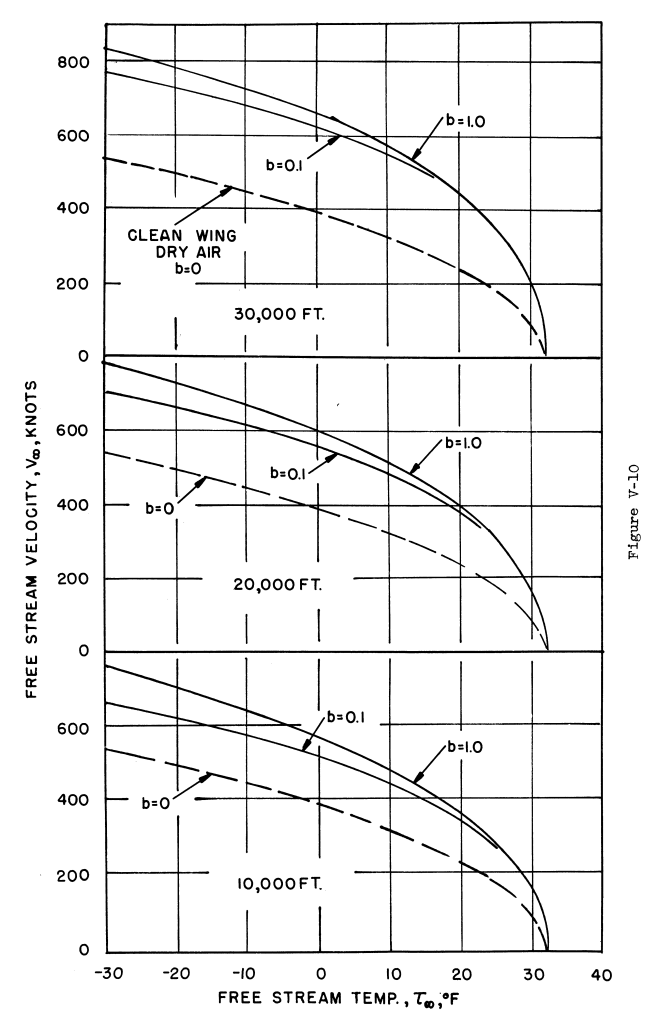
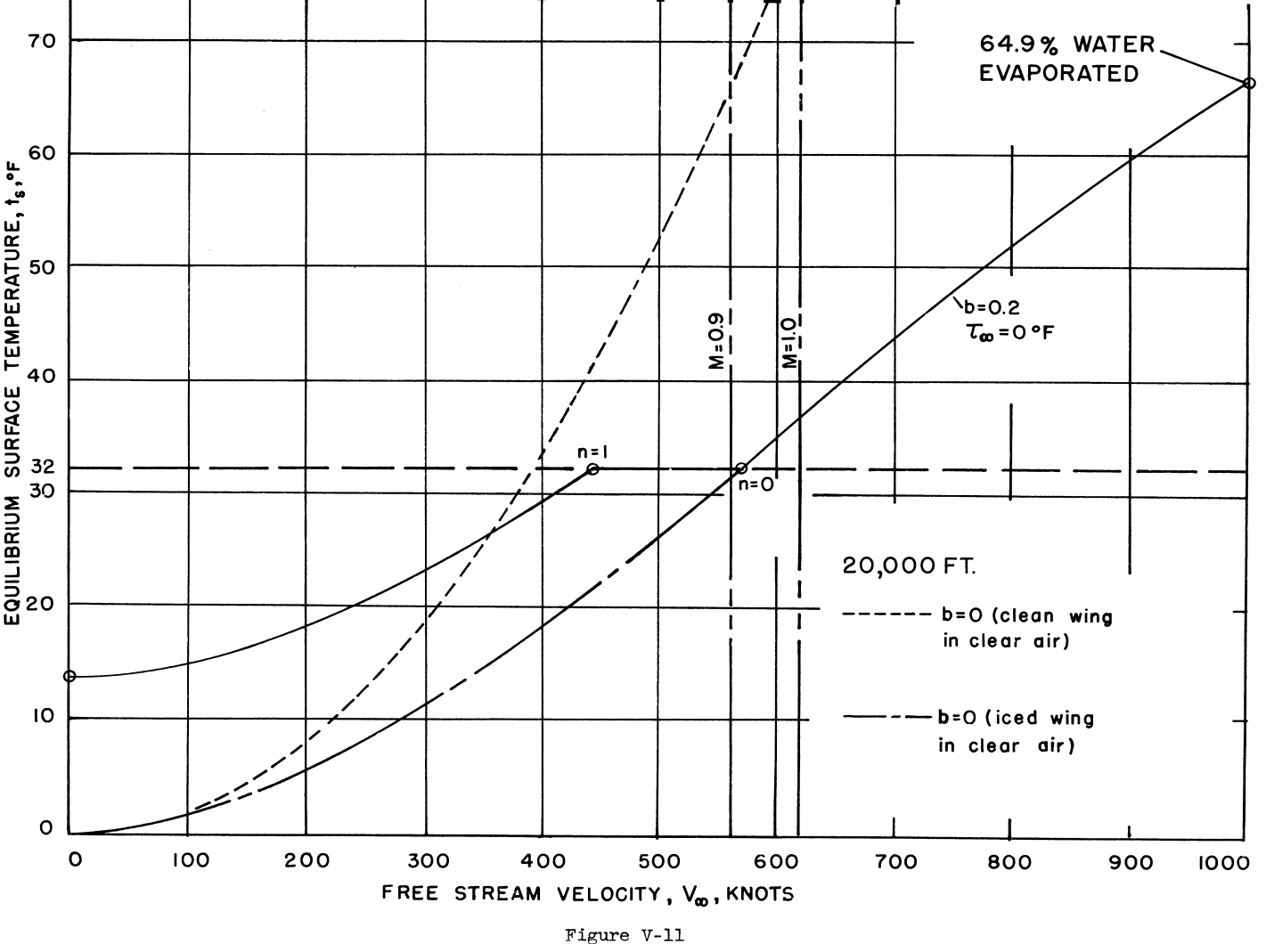
[The figure appears to be cut off like this in the print copy.]
Airplane Icing Information Course 3
"Modern Icing Technology" formed a basis for the Airplane Icing Information Course that was held the next year, 1953. Several invited speakers led sessions on numerous topics. One of those was Bernard L. Messinger with "Energy Exchanges During Icing". Apparently Tribus' earlier use of the work of Messinger was approved of. I plan a future thread on the Airplane Icing Information Course.
One of the topics in the 1953 Airplane Icing Information Course was "air-heated systems for the continuous prevention of ice formation", NACA-TN-3130, which was a design manual, and we will cover it below.
"The Design of Air-Heated Ice-Prevention Systems" NACA-TN-3130 4
SUMMARY A procedure proposed for use in the design of air-heated systems for the continuous prevention of ice formation on airplane components is set forth. Required heat-transfer and air-pressure-loss equations are presented, and methods of selecting appropriate meteorological conditions for flight over specified geographical areas and for the calculation of water-drop-impingement characteristics are suggested.
In order to facilitate the design, a simple electrical analogue was devised which solves the complex heat-transfer relationships existing in the thermal-system analysis. The analogue is described and an illustration of its application to design is given.
This goes into much detail (64 pages).
Thermal analysis in 2D was performed. Figure 15 shows the control volumes used. Figure 17 shows the circuit diagram of the electrical analog. Figure 9 shows some analysis results.
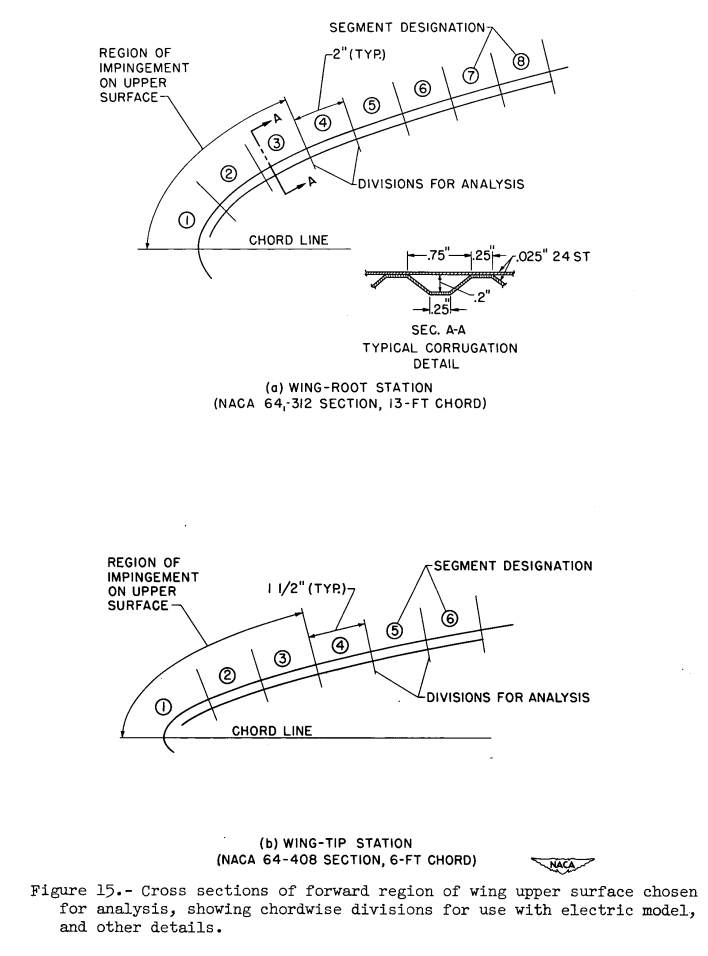
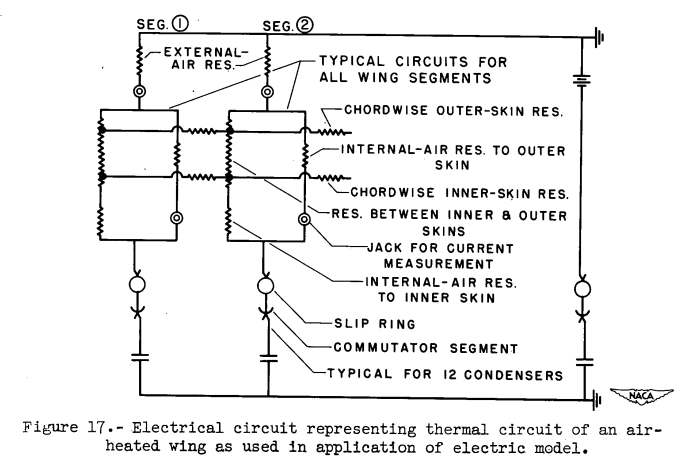

"A Design Manual for Thermal Anti-Icing Systems", WADC Techical Report 54-313 5
This design manual was put together by the Wright Air Development Center, a US Army Air Force (later Air Force) base. This is quite extensive (303 pages).
ABSTRACT This manual deals with the thermal anti-icing of aircraft wing and tail surfaces which are protected by double-skin heaters. After a brief introduction, reference material is presented for pressure drop of duct components, water impingement on airfoils, and coefficients of heat and mass transfer by convection. The last parts of the manual are devoted to mass and heat balance on airfoils and to a design procedure presented from the viewpoint of performance analysis.
Chapter I INTRODUCTION
Scope and Objectives.
This manual deals with steady-state, or continuous-, thermal anti-icing of wing and tail surfaces. The heating medium of any system considered here is assumed to be hot air flowing along inner surfaces of the skin, that is, through so-called double-skin heat exchangers.
Specific objectives of the manual are to provide methods and reference material for the design of continuous thermal anti-icing systems in wings and empennages insofar as the thermal design is to be considered. Other aspects of the design, such as the selection of a heat source, the performance of the power plant during icing conditions, the effect on range of flight, the economic aspects, etc, are not treated here but may be found in other places. For example, Tribus (Ref. 124, Chapter III) deals with some of these problems.
While only anti-icing is being considered, a large amount of the reference material, such as the data from calculation of waterdrop trajectories, may be used for calculations, on mechanical, chemical, and cyclic de-icing systems.
Reference 124 is Tribus' "Modern Icing Technologies", which we saw above. Messinger is (of course) also referenced, as well as NACA-TN-3130.
While many of the 133 citations are NACA publications, there are many from ASME and other sources that concern the movement of air in pipes. This shows a maturation of the design process. While much analysis concerns the outer surface of a wing (ambient air flow and water drop impingement), which is often performed by an aerodynamics group, much of what gets "designed" in such an ice protection system is what is inside the wing, which is often the provence of an air conditioning group that is familiar with duct design.

Almost half of the pages are on water drop catch efficiency, and there are many figures similar to figure 3-12.
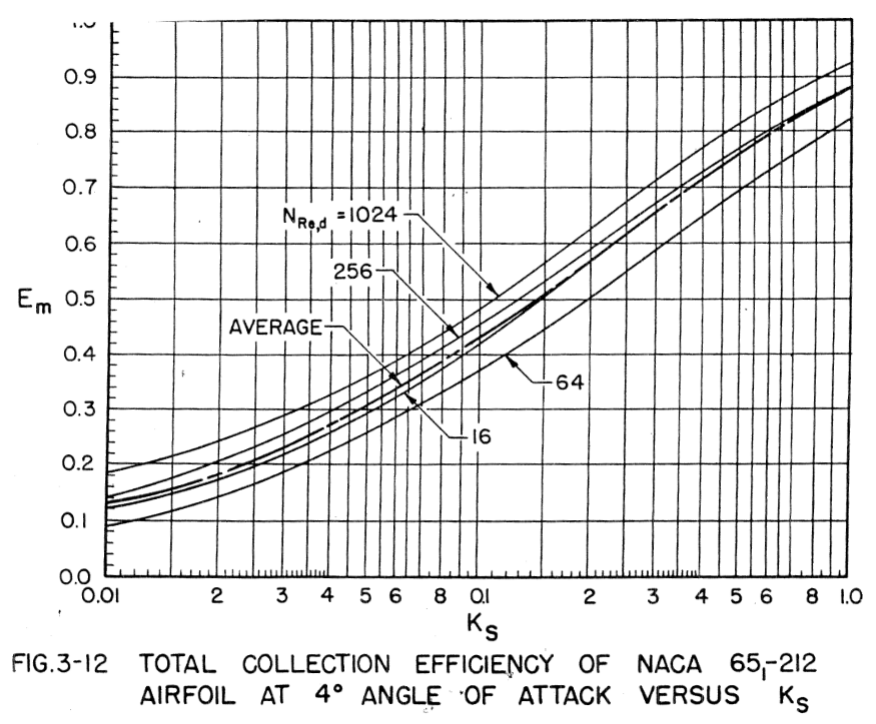
A thermal detail allows a seemingly 3D problem of thermal conduction in the internal heating passages to be simplified to a 1D heat conduction effectiveness factor.

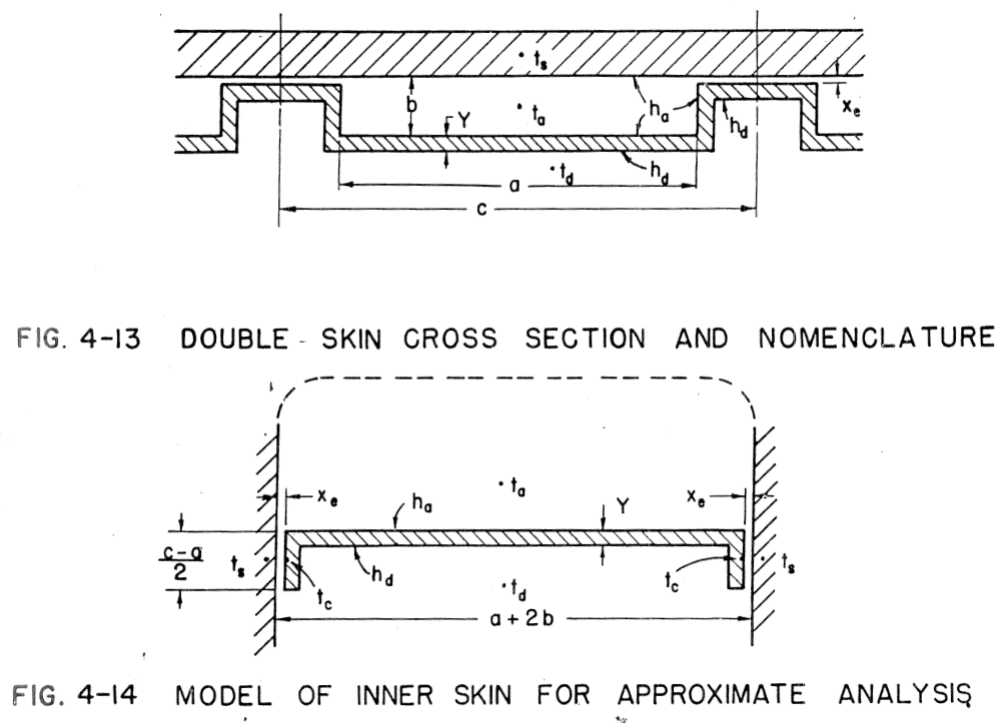

“Engineering Summary of Airframe Icing Technical Data” ADS-4 1
ADS-4 is extensive (384 pages).
This report provides, in a single reference document, an engineering summary of selected technical data on airframe icing conditions, methods of detecting, preventing, and removing ice from airframes in flight, and methods of testing ice protection systems to ensure their adequacy. An aircraft engineer can use this report to design adequate ice protection systems for any type aircraft for any flight mission profile.
The work done in preparing this report covered a survey, study, analysis, and summary of the vast amount of technical literature on airframe icing available in the world today. Key technical data on airframe icing was selected and summarized for the report. Results of the work provide a design engineer with the following:
a. Complete statistical data on the earth's icing weather conditions that can be used as design criteria for airframe ice protection systems.
b. An explanation of the physics of airframe ice collection.
c. A discussion of known methods of airframe ice protection, and formulas and data to be used in their design.
d. Selected specific applications of ice protection systems to conventional aircraft airframes.
e. Data on known methods and systems for detection of airframe icing.
f. Various methods of testing ice protection systems and aircraft for adequacy.
We already reviewed part of ADS-4. Rather than the 2D analysis of NACA-TN-3130, ADS-4 describes a 1D analysis where ice protection performance on a surface (upper or lower wing) is described with a single, averaged control volume (from NACA-TN-2799).
The other sections go well beyond the thermal aspects, and provide much information to help avoid "details which have not been anticipated before the de-icing tests were started".
Conclusions
By 1963 the comprehensive ADS-4 was available. Aircraft icing was largely viewed as a "solved" problem. NACA had been subsumed by NASA, and NASA resources were largely devoted to other tasks, such as space exploration (ADS-4 was published by the FAA, not NASA).
The 1969 Aircraft Ice Protection Symposium
sponsored by the FAA had 16 presentations.
Two were by former NACA employees, and presented prior work.
The new data presented were from other entities,
such as industry and the US Air Force.
The Historical Selected Bibliography of NACA-NASA Icing Publications also had
its first appearance at the symposium,
and was still relevant when republished in 1981.
The Selected Bibliography includes ADS-4, even though it is not a
NACA or NASA publication.
“Ice, Frost, and Rain Protection” part of the SAE Applied Thermodynamics Manual 6, was first published in 1969. It covers many of the same topics as ADS-4. The current version is listed as "stabilized" by the SAE, which means it will not be revised unless a need arises (rather than reviewed every 5 years, like many active documents). People say that they still use it. It is frankly getting dated. While nothing in it is wrong, it does not address many current design tools and challenges such as 3D computational fluid dynamics (CFD) icing analysis.
If “Ice, Frost, and Rain Protection” is getting dated, I am partly to blame, as I have served on the SAE AC9C Aircraft Icing Technology committee that sponsors the document. We have not found the motivation for the extensive re-write that might be required to address recent topics.
Recent topics are being addressed in other avenues. The AIAA has an Ice Prediction Workshop 7 that addresses 3D ice shape tools, but not ice protection, and it is planned to last several more years, and has not yielded something like a new design manual.
Some day I might write a review of the “Aircraft Icing Handbook" 8, but not today. It is also perhaps a little dated. The abstract discusses ADS-4:
Periodically the Federal Aviation Administration (FAA) provides documentation to assist regulatory certification teams and industry design engineers in standardizing testing and validating procedures. Examples of such documentation are "Engineering Summary of Airframe Icing Technical Data" FAA Report No. ADS-4 dated December 1964. and "EngineeringSummary of Powerplant Icing Technical Data." FAA Report No. RD-77-76, dated July 1977. Although most of the information contained in these reports is still valid. some is outdated. and more usable information is now available through recent research and experience. Therefore. this work was directed towards developing an updated and more comprehensive combined version of Report ADS-4 and RD-77-76 that includes reference material on ground and airborne icing facilities. simulation procedures and analytical techniques. This document represents all types and classes of aircraft and is intended as a working tool for the designer and analyst of ice protection systems.
ADS-4 was the predominant design reference for decades. The DOT/FAA “Aircraft Icing Handbook” 8 was published in 1991, and re-used large portions of ADS-4.
I have used many of the methods from ADS-4. While nomographs and 1D analysis may seem simplistic, they yield reliable results. I have also used 3D analysis tools. Frankly, if the 3D results do not agree with 1D analysis by, say, +/20 % I would re-check what I did in the 3D analysis.
ADS-4 has been used for decades, and is a crowning achievement of the NACA-era.
Notes
-
Bowden, D.T, et.al., “Engineering Summary of Airframe Icing Technical Data”, FAA Technical Report ADS-4, General Dynamics/Convair, San Diego, California, 1964. apps.dtic.mil ↩↩
-
Tribus, Myron: "Modern Icing Technology" 1952. lib.umich.edu ↩
-
University of Michigan. College of Engineering: Airplane icing information course. Lectures presented in a special program at the University of Michigan, Ann Arbor, March 30-April 3, 1953. search.lib.umich.edu ↩
-
"The Design of Air-Heated Ice-Prevention Systems. (Presented at the Airplane Icing Information Course the University of Michigan, April 1953)", NACA-TN-3130, 1954. ntrs.nasa.gov ↩
-
Sogin, H. H.: A Design Manual for Thermal Anti-Icing Systems. WADC TR 54-313, December 1954. ntrl.ntis.gov ↩
-
“Ice, Frost, and Rain Protection”, SAE Aerospace Applied Thermodynamics Manual, 1969 (regularly updated, currently document sae.org) ↩
-
1st AIAA Ice Prediction Workshop in Conjunction with the AIAA AVIATION 2021 Forum All Virtual/Remote Participation 26-29 July 2021, icepredictionworkshop.wordpress.com ↩
-
“Aircraft Icing Handbook Volume 1.” DOT/FAA/CT-88/8-1 (1991) apps.dtic.mil.
Also note that there was a perhaps little known update in 1993 (that did not affect the pages of interest herein): apps.dtic.mil. ↩↩